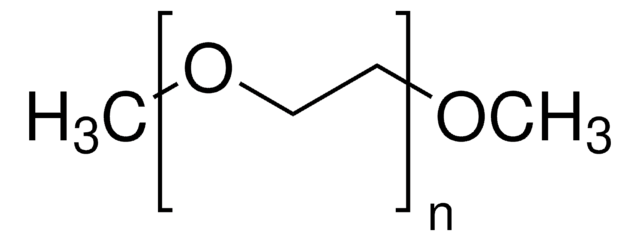71578
Poly(ethylene glycol) methyl ether
BioUltra, 500
Sinónimos:
Polyethylene glycol monomethyl ether
About This Item
Productos recomendados
densidad de vapor
>1 (vs air)
presión de vapor
0.05 mmHg ( 20 °C)
descripción
non-ionic
Línea del producto
BioUltra
formulario
paste
viscous liquid (clear)
mol peso
470-530
impurezas
insoluble matters, passes filter test
≤0.005% peroxides (as H2O2)
pH
5.5-7.0 (25 °C, 50 mg/mL in H2O)
mp
20 °C (lit.)
solubilidad
H2O: 50 mg/mL at 25 °C, clear, colorless
trazas de anión
chloride (Cl-): ≤50 mg/kg
sulfate (SO42-): ≤50 mg/kg
trazas de catión
Al: ≤5 mg/kg
As: ≤0.1 mg/kg
Ba: ≤5 mg/kg
Bi: ≤5 mg/kg
Ca: ≤10 mg/kg
Cd: ≤5 mg/kg
Co: ≤5 mg/kg
Cr: ≤5 mg/kg
Cu: ≤5 mg/kg
Fe: ≤5 mg/kg
K: ≤200 mg/kg
Li: ≤5 mg/kg
Mg: ≤5 mg/kg
Mn: ≤5 mg/kg
Mo: ≤5 mg/kg
Na: ≤200 mg/kg
Ni: ≤5 mg/kg
Pb: ≤5 mg/kg
Sr: ≤5 mg/kg
Zn: ≤5 mg/kg
λ
50 mg/mL in H2O
Absorción UV
λ: 260 nm Amax: 0.06
λ: 280 nm Amax: 0.03
grupo funcional
hydroxyl
InChI
1S/C3H8O2/c1-5-3-2-4/h4H,2-3H2,1H3
Clave InChI
XNWFRZJHXBZDAG-UHFFFAOYSA-N
¿Está buscando productos similares? Visita Guía de comparación de productos
Código de clase de almacenamiento
10 - Combustible liquids
Clase de riesgo para el agua (WGK)
WGK 1
Punto de inflamabilidad (°F)
359.6 °F - closed cup
Punto de inflamabilidad (°C)
182 °C - closed cup
Equipo de protección personal
Eyeshields, Gloves
Certificados de análisis (COA)
Busque Certificados de análisis (COA) introduciendo el número de lote del producto. Los números de lote se encuentran en la etiqueta del producto después de las palabras «Lot» o «Batch»
¿Ya tiene este producto?
Encuentre la documentación para los productos que ha comprado recientemente en la Biblioteca de documentos.
Los clientes también vieron
Nuestro equipo de científicos tiene experiencia en todas las áreas de investigación: Ciencias de la vida, Ciencia de los materiales, Síntesis química, Cromatografía, Analítica y muchas otras.
Póngase en contacto con el Servicio técnico



